Abstract
Lipid profiling of human plasma by liquid chromatography-electrospray ionization coupled to mass spectrometry (LC–ESI-MS) is being used to identify biomarkers of health, disease, and treatment efficacy. However, there is no consensus on the choice of anticoagulant to perform and compare lipidomic measurements. This study assessed the effect of the anticoagulants citrate, EDTA, and heparin, on eight synthetic and 80 plasma lipids, and compared lipidomic data among anticoagulants. Lipid extraction was affected distinctively by the anticoagulant of choice likely due to the different physico-chemical properties among anticoagulants. Peak areas of seventy endogenous lipids showed significant differences between citrate–heparin and EDTA–heparin comparisons similar to those observed for synthetic lipids. Only ten endogenous lipid species showed comparable peak areas among the three anticoagulants. Correction by a structurally related internal standard only partly eliminated differences among anticoagulants (ANOVA, P value <0.001). However, comparisons among anticoagulants were possible for most endogenous lipids after correction of peak areas by the sum of areas of its lipid class. Our observations indicate that the choice of anticoagulant distinctively impact the peak response of most lipid species by LC–ESI-MS. Lipidomic data from plasma obtained with different anticoagulants should address differences in matrix effects and extraction procedures since ion strength, plasma pH, and different physicochemical properties among anticoagulants influence lipid extraction and LC–ESI-MS analysis.



Similar content being viewed by others
References
Barton, R. H., Waterman, D., Bonner, F. W., Holmes, E., Clarke, R., Nicholson, J. K., et al. (2009). The influence of EDTA and citrate anticoagulant addition to human plasma on information recovery from NMR-based metabolic profiling studies. Molecular BioSystems, 6(1), 215–224. doi:10.1039/b907021d.
Bergheanu, S. C., Reijmers, T., Zwinderman, A. H., Bobeldijk, I., Ramaker, R., Liem, A.-H., et al. (2008). Lipidomic approach to evaluate rosuvastatin and atorvastatin at various dosages: Investigating differential effects among statins. Current Medical Research and Opinion, 24(9), 2477–2487. doi:1185/03007990802321709.
Bligh, E., & Dyer, W. (1959). A rapid method of total lipid extraction and purification. Canadian Journal of Biochemistry and Physiology, 37, 911–917.
Christensen, J. M., & Stalker, D. (1991). Ibuprofen piconol hydrolysis invitro in plasma, whole-blood, and serum using different anticoagulants. Journal of Pharmaceutical Sciences, 80(1), 29–31. doi:10.1002/jps.2600800108.
Evans, M. J., Livesey, J. H., Ellis, M. J., & Yandle, T. G. (2001). Effect of anticoagulants and storage temperatures on stability of plasma and serum hormones. Clinical Biochemistry, 34(2), 107–112.
Graessler, J., Schwudke, D., Schwarz, P. E. H., Herzog, R., Shevchenko, A., & Bornstein, S. R. (2009). Top-down lipidomics reveals ether lipid deficiency in blood plasma of hypertensive patients. PLoS One, 4(7), e6261.
Gross, Richard. W., & Han, X. (2011). Lipidomics at the interface of structure and function in systems biology. Chemistry & Biology, 18(3), 284–291.
Hu, C., van Dommelen, J., van der Heijden, R., Spijksma, G., Reijmers, T. H., Wang, M., et al. (2008). RPLC-ion-trap-FTMS method for lipid profiling of plasma: Method validation and application to p53 mutant mouse model. Journal of Proteome Research, 7(11), 4982–4991. doi:10.1021/pr800373m.
Jessome, L. L., & Volmer, D. A. (2006). Ion suppression: A major concern in mass spectrometry. LCGC North America, 24, 498–510.
Johnstone, I. B. (1993). The importance of accurate citrate to blood ratios in the collection of canine blood for hemostatic testing. Canadian Veterinary Journal (Revue Veterinaire Canadienne), 34(10), 627–629.
Kirschner, L. B. (1958). The cation content of phospholipids from swine erythrocytes. Journal of General Physiology, 42(2), 231–241.
Mastovska, K., Lehotay, S. J., & Anastassiades, M. (2005). Combination of analyte protectants to overcome matrix effects in routine GC analysis of pesticide residues in food matrixes. Analytical Chemistry, 77(24), 8129–8137. doi:10.1021/ac0515576.
Matuszewski, B. K. (2006). Standard line slopes as a measure of a relative matrix effect in quantitative HPLC-MS bioanalysis. Journal of Chromatography B—Analytical Technologies in the Biomedical and Life Sciences, 830(2), 293–300. doi:10.1016/j.jchromb.2005.11.009.
Mei, H., Hsieh, Y. S., Nardo, C., Xu, X. Y., Wang, S. Y., Ng, K., et al. (2003). Investigation of matrix effects in bioanalytical high-performance liquid chromatography/tandem mass spectrometric assays: Application to drug discovery. Rapid Communications in Mass Spectrometry, 17(1), 97–103. doi:10.1002/rcm.876.
Mori, T. A., Mas, E., Barden, A. E., Zahra, P., & Croft, K. D. (2012). Measurement of resolvins and protectins using liquid chromatography-tandem mass spectrometry: Comparison of plasma and serum levels in humans. ISSFAL Conference: Poster, Vancouver, Canada.
Peoples, M. C., Halquist, M. S., Ismaiel, O., El-Mammli, M. Y., Shalaby, A., & Karnes, H. T. (2008). Assessment of matrix effects and determination of niacin in human plasma using liquid–liquid extraction and liquid chromatography-tandem mass spectrometry. Biomedical Chromatography, 22(11), 1272–1278. doi:10.1002/bmc.1057.
Quehenberger, O., & Dennis, E. A. (2011). The human plasma lipidome. New England Journal of Medicine, 365(19), 1812–1823. doi:10.1056/NEJMra1104901.
Stein, P. E., & Goodier, D. W. (1986). Effect of in vitro sodium citrate anticoagulant on results of arterial blood gas analysis. Journal of Clinical Pathology, 39(9), 1046.
Szymańska, E., van Dorsten, F., Troost, J., Paliukhovich, I., van Velzen, E., Hendriks, M., et al. (2011). A lipidomic analysis approach to evaluate the response to cholesterol-lowering food intake. Metabolomics, 1–13. doi:10.1007/s11306-011-0384-2.
Taylor, P. J. (2005). Matrix effects: The Achilles heel of quantitative high-performance liquid chromatography-electrospray-tandem mass spectrometry. Clinical Biochemistry, 38(4), 328–334. doi:10.1016/j.clinbiochem.2004.11.007.
Viswanathan, C. T., Bansal, S., Booth, B., DeStefano, A. J., Rose, M. J., Sailstad, J., et al. (2007). Quantitative bioanalytical methods validation and implementation: Best practices for chromatographic and ligand binding assays. Pharmaceutical Research, 24(10), 1962–1973. doi:10.1007/s11095-007-9291-7.
Xia, J., Psychogios, N., Young, N., & Wishart, D. S. (2009). MetaboAnalyst: A web server for metabolomic data analysis and interpretation. Nucleic Acids Research, 37(suppl 2), W652–W660. doi:10.1093/nar/gkp356.
Yi, J., Craft, D., & Gelfand, C. A. (2011). Minimizing preanalytical variation of plasma samples by proper blood collection and handling. Methods in Molecular Biology, 728(2), 137–149. doi:10.1007/978-1-61779-068-3_8.
Yu, Z., Kastenmaller, G., He, Y., Belcredi, P., Maller, G., Prehn, C., et al. (2011). Differences between human plasma and serum metabolite profiles. PLoS One, 6(7), e21230.
Acknowledgments
The excellent assistance of Peter Schouten from The Centre for Human Drug Research and enriching discussions with Amy Harms, Marek Noga, and Robert-Jan Raterink from the Netherlands Metabolomics Centre are gratefully acknowledged. This project was (co)financed by the Netherlands Metabolomics (NMC) which is part of the Netherlands Genomics Initiative/Netherlands Organisation for Scientific Research.
Author information
Authors and Affiliations
Corresponding author
Electronic supplementary material
Below is the link to the electronic supplementary material.
Rights and permissions
About this article
Cite this article
Gonzalez-Covarrubias, V., Dane, A., Hankemeier, T. et al. The influence of citrate, EDTA, and heparin anticoagulants to human plasma LC–MS lipidomic profiling. Metabolomics 9, 337–348 (2013). https://doi.org/10.1007/s11306-012-0450-4
Received:
Accepted:
Published:
Issue Date:
DOI: https://doi.org/10.1007/s11306-012-0450-4




